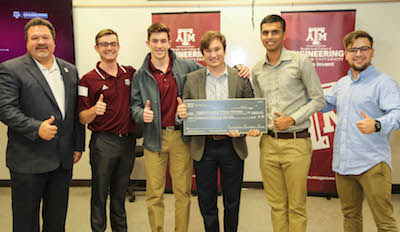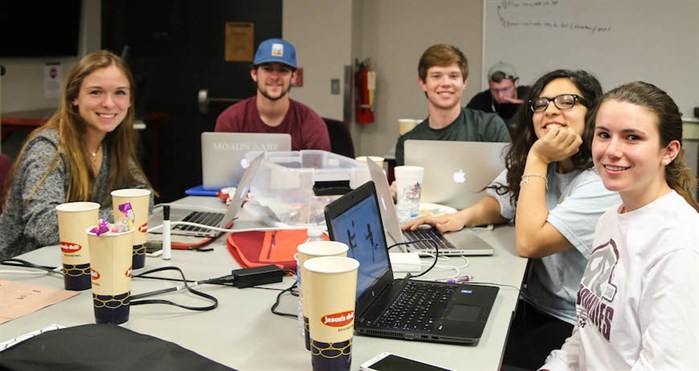Improved training techniques, safety monitoring and rehabilitation methods were the focus of the most recent Aggies Invent: Sports. Students looked at all perspectives of sports from safety to training to recovery, and knocked it out of the park with their innovations.
Aggies Invent: Sports tasked students with designing solutions relevant to sports whether that be to improve the health and safety for athletes, training devices and equipment and workout aids. Almost 50 students from across campus participated in the weekend.
Aggies Invent promotes an innovation and entrepreneurial mindset among students at Texas A&M University. It gathers invited students, provides them with the needs statements submitted by sponsors, allows them to self-select teams, gives them access to industry mentors and support from the Engineering Innovation Center (EIC) to create solutions and prototypes in 48 hours.
“It’s exciting to have a relationship with engineering that brings focus to improving sport devices and activities,” explained Richard B. Kreider, professor and department head of health and kinesiology. “Engineering and sport go hand in hand and technology is such an important factor for advances in sport.”
First, second and third place were awarded $1,000, $750 and $500, respectively, for their innovations. The judges were very impressed with the teams and decided to add a fourth prize to the list. A new category, most market potential, was added for a prize of $250.
 Pocket Trainer, a wearable aid to ensure physical therapy was performed properly, was awarded first place. Team members included Will Davis, Zachary Reinisch, Martin Jeffers, Siddhartha Regmi and Eric Matthews. Their Pocket Trainer provides speed and range of motion sensor technology to track training and rehabilitation exercises.
Pocket Trainer, a wearable aid to ensure physical therapy was performed properly, was awarded first place. Team members included Will Davis, Zachary Reinisch, Martin Jeffers, Siddhartha Regmi and Eric Matthews. Their Pocket Trainer provides speed and range of motion sensor technology to track training and rehabilitation exercises.
Stretch Armstrong, in second place, created a wearable device to measure the acceleration, motion and direction in a three-dimensional format for rehabilitation and training purposes. Team members include Utashya Shah, Craig Medlin, Michael Walker, Nathan Stephens, Usman Muhammad and Gerardo Vazquez.
The third place team created the Drill Drone. Its programmable drone allows athletes to train with the drone for enhanced agility and speed training. The drone acts as a personalized trainer with the ability to capture motion and acceleration and will measure and record progress. Brendan Cooper, Taylor Frederick, Austin Lu, Ty Jahns, Xin Xing and Ankit Singh were the team members.
The final team the judges deemed to have the greatest market potential is H2U, a dehydration detection system. Its wearable device is capable of continuous monitoring of an athlete’s hydration status, a critical factor for high performing athletes especially in the heat. The team had the added benefit of two Texas A&M student athletes who could attest to the need for this product. Team members included Ian Sequeira, Adam Curtis, Kate Hajdu, Sarah Gibson and Yi Yan.
This Aggies Invent was judged by Dr. Steven Riechman, associate professor and chair from the department of health and kinesiology; Kreider; Jim Wilson, EIC facility manager; and Grace Fletcher, Aggies Invent engineering mentor and former Aggies Invent winner.

The innovation does not stop now. Teams are invited to continue working on their project and will have access to the EIC and mentors to help them improve their idea and create more advanced prototypes. Rodney Boehm, event organizer, director of Aggies Invent and associate professor of practice, serves as the mentor for each team throughout this process. Teams also have the opportunity to work with Startup Aggieland.
“You need an innovative team approach to solving these problems,” Kreider said. “And engineering has to play a role in this team.”